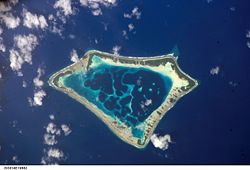Germany may have the largest solar power capacity on the planet but on the best of days (sunny spring and summer weekends) it can meet barely 50% of the power needs of the country. On the other hand there is Tokelau, a tiny island nation on 3 atolls (see picture below) to the north of New Zealand. It intends to provide 100% of its citizens power needs through a solar and storage system it is putting in place with the help of New Zealand.
Tokelau has 1,711 residents. Up until now the inhabitants of the three islands (Atafu, Nukunonu and Fakaofo) have relied on diesel-fueled generators for power. But bringing in 2,000 barrels of diesel per year with no harbor to speak of has proven to be a logistical nightmare.
The three solar arrays on Tokelau, one on each of the islands have a capacity of one Megawatt, supplying 70% of the islands’ total energy needs. The solar arrays are backed up by storage units that will receive excess solar energy during the day and release it for overnight needs.
Tokelau is not atypical of South Pacific islands. Most have had to import fossil fuels to run generators. Tonga, the Cook Islands, Tuvalu and Soma are also in the process of building solar power plants to decrease their reliance on diesel. New Zealand is providing engineering and technical assistance to all these island nations.
Why the move to photovoltaics now? Because the price of the technology has declined dramatically in the last 5 years, and the solar to electricity conversion efficiency is improving. In addition technology that includes battery storage and inverters that convert DC from solar to AC electricity for home use, such as the one recently announced by Panasonic, are also becoming commercially available for residential use.















